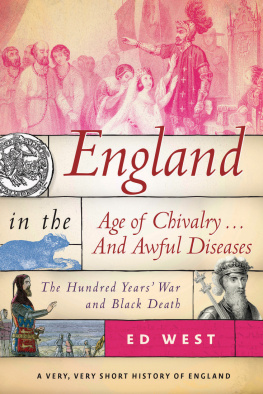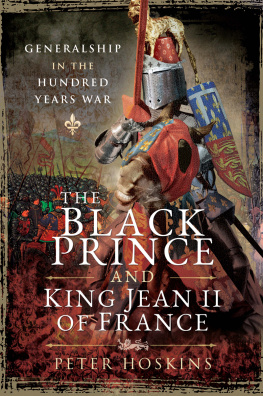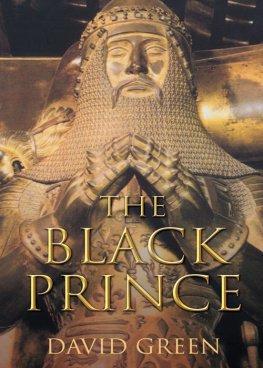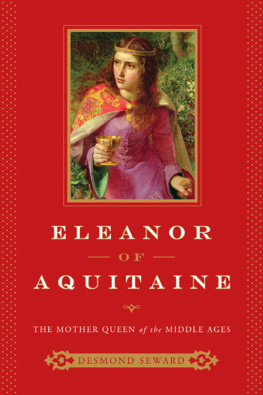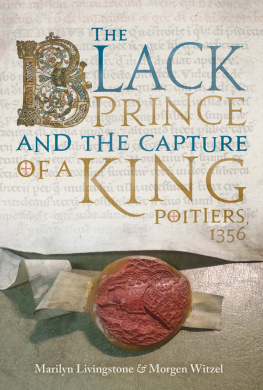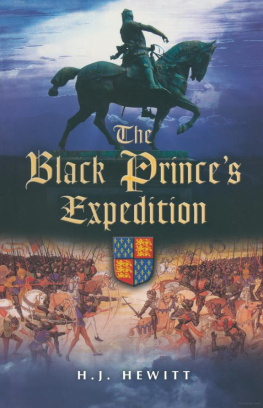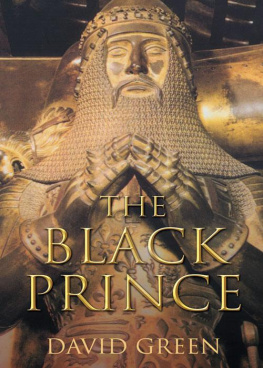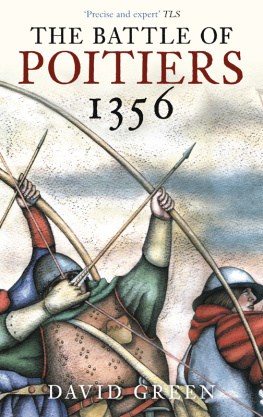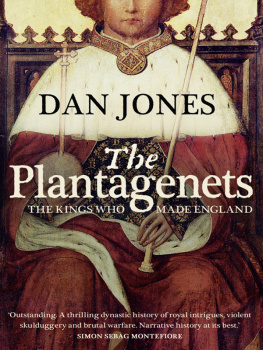
It has been a pleasure to tell the story of the Black Prince, a true chivalric hero of medieval England. I wrote my thesis on the Hundred Years War at the University of Bristol with the help of James Sherborne, and will always be grateful for his many insights into fourteenth-century campaigning and his support and friendship. Jamess important article on John of Gaunts 1369 expedition appeared at this time, alongside the book Froisxsart: Historian, which he co-edited with John Palmer. The chronicler Jean Froissart presents a challenge for every historian: at his best, he is well sourced and brings the period to life; however, he can also be unreliable and cavalier with the facts. John Palmer remarked that Froissart gave us a unique window on his age; James added that the chronicler was quite happy to make things up. Both comments are true, and it is a dilemma that inevitably affects this book. I have tried to use Froissart when I feel he is reliable, but have also challenged his narrative of the Black Princes later military career.
I would like to thank the many people who have encouraged my work, particularly Guilhem Ppin, whose own research on the Princes administration in Aquitaine has brought important new source material into play and provided a corrective to some of the overly critical chronicle accounts. Professor Michael C. E. Joness grasp of fourteenth-century political life in general, and the career of Bertrand du Guesclin in particular, has considerably assisted my own work, as have the major contributions to our understanding of the warfare of that period from Professors Clifford Rogers, Matthew Strickland and Kelly DeVries, alongside Dr Philip Morgans study of war and society in medieval Cheshire. Sir Philip Preston has been a friend and supporter, and it has always been a pleasure to guide the battlefield of Crcy with him; Professor Andrew Ayton has shared his insights into that battle and late medieval military retinues in general. Richard Eales kindly gave me material on Gaston Fbuss castle at Pau and Orthez. Professor Carole Rawcliffe has discussed the Black Princes illness with me; to Dr Ian Mortimer I am grateful for his enthusiasm and understanding of the reign of Edward III and late medieval society as a whole.
My book draws on the scholarship of many others, and among the acknowledgements in the Notes and Bibliography I am particularly grateful to Richard Barber, whose own biography of the Prince, collection of source material, and scholarship on Edward III and chivalry, have been enormously helpful, as has the work of Dr David Green on the Princes life, its political context and especially the functioning of his retinue. For the broader background, the magisterial survey of the Hundred Years War by Jonathan Sumption has been an essential port of call, alongside the work of Professors Kenneth Fowler, Michael Prest-wich and Mark Ormrod. For the Black Princes career in Cheshire, and a broader examination of his life and motivation, I have found the books and articles of Professor Paul Booth of considerable value. I am grateful to everyone involved with the Gascon Rolls project (www.gasconrolls.org). Work on the Princes life is progressing all the time, and it is a pleasure to thank Peter Hoskins, for his examination of the itineraries of the campaigns of 1355 and 1356, and Mollie Madden, for her research on their logistical operation.
A medieval biography needs to tell a story, and draw upon the chronicle and documentary sources to make that narrative come alive. I would like to thank the staff at The National Archives, and the Duchy of Cornwall Record Office, for permission to use John Henxteworths Day Book. I have felt it particularly important to bring fresh French archival material into play for the latter part of the Princes rule over Aquitaine, and for this I am grateful to the staff at the Archives Nationales and Bibliothque Nationale in Paris, the departmental archives at Agen, Bordeaux, Cahors, Limoges and Pau, the municipal records at Cognac, Millau and Poitiers and, for the 1367 Njera campaign, the Spanish material in the Archivo General de Navarra at Pamplona.
I would like to thank Anthony Cheetham, Richard Milbank, Ellen Parnavelas and everyone at Head of Zeus, and my agent Charlie Viney, for their encouragement and support as this book was written.
And finally, as history is all about making a connection with the past, I would like to thank Sarah Turner, the Collections Manager at Canterbury Cathedral, and Karen Brayshaw, the Librarian, for allowing me to view the Black Princes funeral achievements and some of the manuscripts concerning his life from the cathedral archives. And I wish them well with the Canterbury Journey project, and its new plans to present the artefacts of one of our greatest warriors to the general public.
ALSO BY MICHAEL JONES
Bosworth 1485
Black Propaganda and the Sack of Limoges
In the Middle Ages, a chivalric hero was charismatic and generous, and able to win others to his cause; but he could also be the target of rumour, insinuation and slander. At the beginning of Edward IIIs reign, the king was accused of the murder of his brother, John of Eltham, in 1336, and the seduction and rape of Catherine Grandi-son, the wife of his closest friend and martial companion William, earl of Salisbury, while William was abroad on royal service in 1342. In both cases, the charges were made by one chronicler (John of Fordun and Jean le Bel respectively). Historians have assessed them in the light of other chronicle accounts and documentary evidence, and found both reports to be extremely unlikely. In the case of John of Eltham, the cause of his death (at Perth on 13 September) is unclear it may have been of fever but the king was very close to his brother and grief-stricken at his loss. And the rumour concerning the countess of Salisbury was almost certainly devised by Jean le Bel in an attempt to blacken Edwards reputation.
For the Princes so-called sack of Limoges on 19 September 1370 we are again largely reliant on one chronicler, Jean Froissart. Froissarts account is echoed in a much briefer comment by Thomas Walsing-ham, who spoke of the Princes anger, adding that, after the city was captured he almost totally destroyed it, and killed all those he found there, a few only being spared their lives and taken prisoner. But elsewhere Walsingham described Limoges as one of the military operations the Prince was most proud of, saying in terms of his illness that it was sad to see the victor of Poitiers, Njera and Limoges in such an enfeebled state. The Chandos Herald only remarked that everyone there was either killed or taken, a comment more likely referring to those bearing arms rather than the civilian population as a whole. The local chronicler of the abbey of Saint-Martial said that they pillaged the city and then set it on fire, but gave the figure of those dead as 300, not 3,000.
To these responses we can add the comments of Christine de Pizan, the contemporary biographer of Charles V, who did not mention any massacre of civilians, and simply put the siege of Limoges in the context of military actions in the summer of 1370, stressing the relative failure of the planned offensive, and that a new war strategy was adopted by Bertrand du Guesclin soon after he became constable of France. She gave the number of those killed and taken prisoner as 400. The full range of source material, including archaeological evidence, confirms that the part of Limoges known as the cit was badly damaged in the siege of 1370, and many houses burned to the ground. But on the sequence of events that led up to this, Froissarts account is not supported by the full range of chronicle evidence, and it is contradicted by the documentary sources.
Next page



